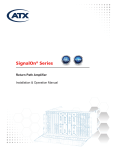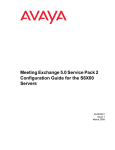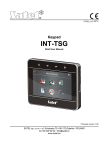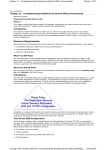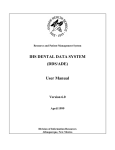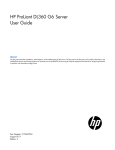Download AGC Pilot Carrier Redundancy User Manual Pdf
Transcript
SM by Status Monitoring And Control Solutions (HMS Compliant, SNMP Based) SMACSM PCR Pilot Carrier Redundancy Platform Installation & Operation Manual Although every effort has been taken to ensure the accuracy of this document it may be necessary, without notice, to make amendments or correct omissions. Specifications subject to change without notice. SMACSM is a service mark of ATX in the United States and/or other countries. Products or features contained herein may be covered by one or more U.S. or foreign patents. Other non-ATX product and company names mentioned in this data sheet are the property of their respective companies. TABLE OF CONTENTS Page 1. OPERATIONAL DETAILS.......................................................................................................................... 1-1 2. INSTALLATION.......................................................................................................................................... 2-1 3. SETTING REDUNDANT OSCILLATOR LEVELS...................................................................................... 3-1 4. SET THRESHOLDS & SET SOFT OSC ATTEN DB DELTA..................................................................... 4-1 5. CONFIGURATION MENU........................................................................................................................... 5-1 6. CONNECTION FOR NORMAL OPERATION............................................................................................. 6-1 7. REPLACEMENT MODULE ORDERING INFO.......................................................................................... 7-1 8. CALIBRATION OF SMAC-PCR RF DETECTORS.................................................................................... 8-1 9. MONITORING............................................................................................................................................. 9-1 9.1. Connecting the Ethernet or Modem Communications Interface....................................................... 9-1 9.2. Software Connection of Ethernet or Modem Communications Interface......................................... 9-1 10. SERVICE & SUPPORT............................................................................................................................. 10-1 10.1. Contact ATX Networks.................................................................................................................... 10-1 10.2. Warranty Information...................................................................................................................... 10-1 SMACSM - PCR Pilot Carrier Redundancy Platform – Installation & Operation Manual i Index of Figures and Tables Figures #1 PC’s Network Settings for Factory Default UPS IP Address....................................9-2 Tables #1 Specifications..........................................................................................................1-1 #2 Block Diagram.........................................................................................................1-2 #3 Administration Level Parameters.............................................................................9-2 #4 Common Module Parameters..................................................................................9-3 #5 Module Specific Parameters....................................................................................9-4 ii SMACSM - PCR Pilot Carrier Redundancy Platform – Installation & Operation Manual CHAPTER 1: OPERATIONAL DETAILS OPERATIONAL DETAILS 1. Operational Details • Detects the failure of up to two system pilot carriers and reinserts internal replacement oscillator. • Reinserts replacement oscillator at two different output levels depending on the reduced level or complete failure of the system pilot carrier. • Monitor and control of all functions through front panel or over the data network (HMS compliant, SNMP v2c) or Web browser. • Phase Lock Loop (PLL) controlled, low spurious oscillators. • LCD display shows the current alarms and allows detector thresholds to be set. • Independent removable and replaceable AC power supplies provide full power redundancy. • Compact 1RU chassis. • Simple two-cable connection. • Suitable for headend and hubsite applications. • Front panel test points for oscillator levels and combined full system output level monitoring. • Field upgradeable and swappable pilot carrier filters and replacement oscillators. Table #1: Specifications SMACSM - PCR Pilot Carrier Redundancy Platform – Installation & Operation Manual 1-1 CHAPTER 1: OPERATIONAL DETAILS RF OUT RF IN RF PILOT DETECTOR BANDPASS FILTER RF PILOT DETECTOR BANDPASS FILTER -20 dB OUTPUT TP NETWORK CONNECTION MONITOR AND CONTROL RJ-45 OSC DETECTOR CRYSTAL OSCILLATOR ATT OSC A INDEPENDENT +24 VDC POWER SUPPLY INDEPENDENT +24 VDC POWER SUPPLY OSC A TP OSC DETECTOR CRYSTAL OSCILLATOR OSC B TP ATT OSC B SMAC – PCR Pilot Carrier Redundancy Switch Table #2: Block Diagram 1-2 SMACSM - PCR Pilot Carrier Redundancy Platform – Installation & Operation Manual CHAPTER 2: INSTALLATION INSTALLATION 2.Installation • Rack-mount the SMAC-PCR unit into your 19” equipment rack using a minimum of two 10 x 32 machine screws in the bottom two holes on the PCR chassis. • Interrupt the Cable System feed and ‘splice’ in the SMAC-PCR using the Rear Panel RF IN and RF OUT connectors. • Connect two IEC 3-prong power cords between each of the two rear panel Power Supply jacks and two 120 VAC electrical outlets. For testing purposes, only one is required to be connected. • The front panel LCD display should quickly flash the ATX Networks splash screen and then show the Status Summary screen indicating the status of the two internal Oscillators, the status of the two System Pilot Carriers and the status of the two DC Power Supplies. • The Pilot A & B, the OSC A & B and PS A & B should not be flashing to indicate that the Oscillators and Power supplies are in good working order and that the SMAC-PCR is detecting your system pilots. SMACSM - PCR Pilot Carrier Redundancy Platform – Installation & Operation Manual 2-1 CHAPTER 2: INSTALLATION This page left intentionally blank. 2-2 SMACSM - PCR Pilot Carrier Redundancy Platform – Installation & Operation Manual CHAPTER 3: SETTING REDUNDANT OSCILLATOR LEVELS SETTING REDUNDANT OSCILLATOR LEVELS 3. Setting Redundant Oscillator Levels • Using a spectrum analyzer or signal level meter, measure the current RF level of the two system pilot carriers by monitoring the SMAC-PCR –20 dB OUTPUT TP connector. • Navigate to the ‘SET-UP MENU’ using the UP/DOWN arrows. Navigate to the ‘SET OSC MODE’ Menu using the LEFT/RIGHT arrows. From here you can enable or disable either of the SMAC-PCR oscillators as desired. NOTE: this will not have any effect on the existing pilot carriers of the system, only whether or not the internally generated carriers will be available. • Adjust system amplifier to compensate for the added loss of the SMAC-PCR. • Navigate to the ‘SET-UP MENU’ using the UP/DOWN arrows. Navigate to the ‘Press Enter to Store RF Levels’ and press Enter to begin an auto-calibration routine, which does the following: a) Samples existing pilot carrier RF levels at the pre-determined frequencies b) Stores these levels as the threshold for normal operation c) Adjust internally generated oscillators to match pilot carrier levels • This platform is designed such that no further set-up is required. However, if the default values are not desired, the following options are available. SMACSM - PCR Pilot Carrier Redundancy Platform – Installation & Operation Manual 3-1 CHAPTER 3: SETTING REDUNDANT OSCILLATOR LEVELS This page left intentionally blank. 3-2 SMACSM - PCR Pilot Carrier Redundancy Platform – Installation & Operation Manual CHAPTER 4: SET THRESHOLDS & SET SOFT OSC ATTEN DB DELTA SET THRESHOLDS & SET SOFT OSC ATTEN DB DELTA 4. Set Thresholds & Set Soft OSC Atten DB Delta • Navigate to the ‘SET-UP MENU’ using the up/down arrows. Navigate to the ‘Set Thresholds’ Menu using the LEFT/ RIGHT arrows. Set the Soft, Hard and Hysteresis Threshold values as required. • Navigate to the ‘SET-UP MENU’ using the up/down arrows. Navigate to the ‘Set Soft Osc Atten’ Menu using the LEFT/RIGHT arrows. Set the Soft Osc Atten dB delta value as required. a) Sft = Soft Fail Threshold – If either pilot drops this dB value below the calibrated set-point, the SMAC PCR enters soft fail for this frequency and will insert a CW carrier at the same frequency. The inserted carrier will be at a lower power than the calibrated level. This value is set at ‘Soft Osc Atten dB Delta’ in the LCD menu (default of 3 dB). b) Hrd = Hard Fail Threshold – If either pilot drops this dB value below the calibrated set-point, the SMAC-PCR enters hard fail for this frequency and will insert a CW carrier at the same frequency, at the same power level that the pilot carrier was at when the calibration was performed. c) Hys = Hysteresis – If the pilot enters a soft or hard fail condition, the pilot level must return to at least this many dB above the threshold in order for the fail condition to be reset. Example: The calibrated pilot level is 40 dBmV, Sft = 5, Hrd = 10, Hys = 3, dB delta = 3 • Once pilot drops below 35 dBmV it enters soft fail mode and SMAC-PCR injects a 37 dBmV CW carrier. • If the pilot then drops to 30 dBmV, the injected carrier rises to 40 dBmV. • Once the pilot carrier power returns to 33 dBmV the injected carrier drops back to soft fail level of 37 dBmV. • The pilot then must drop below 30 dBmV to re-enter hard fail mode, or rise to 38 dBmV to re-enter normal operation and turn off the injected carriers. SMACSM - PCR Pilot Carrier Redundancy Platform – Installation & Operation Manual 4-1 CHAPTER 4: SET THRESHOLDS & SET SOFT OSC ATTEN DB DELTA This page left intentionally blank. 4-2 SMACSM - PCR Pilot Carrier Redundancy Platform – Installation & Operation Manual CHAPTER 5: CONFIGURATION MENU CONFIGURATION MENU 5. Configuration Menu • By pressing F1 or F2 you can return to the Status Summary screen on the front panel LCD display. • Using the UP/DN arrows on the SMAC-PCR front panel, navigate to the CONFIGURATION screen. • Press the RIGHT arrow to see the Configuration settings. • You can use the UP/DN arrows in the Configuration settings menu to navigate the following: o Display Brightness o Network Settings • The first three items are self-explanatory and relate to the LCD display. The last menu item allows you to change the network settings of the device. • To change the Network Settings use the UP/DN arrows in the Configuration settings menu to navigate to Network Settings and then press the Front Panel ENTER button. • This will bring you to the Enter IP address screen. Use the RIGHT/LEFT arrows to select the digit for editing and UP/ DOWN arrows to edit the number. Press ENTER when completed. • This will bring you to the Enter MASK screen. Use the RIGHT/LEFT arrows to select the digit for editing and UP/ DOWN arrows to edit the number. Press ENTER when completed. • This will bring you to the Enter GATEWAY screen. Use the RIGHT/LEFT arrows to select the digit for editing and UP/ DOWN arrows to edit the number. Press ENTER when completed. SMACSM - PCR Pilot Carrier Redundancy Platform – Installation & Operation Manual 5-1 CHAPTER 5: CONFIGURATION MENU This page left intentionally blank. 5-2 SMACSM - PCR Pilot Carrier Redundancy Platform – Installation & Operation Manual CHAPTER 6: CONNECTION FOR NORMAL OPERATION CONNECTION FOR NORMAL OPERATION 6. Connection for Normal Operation • The Pilot A & B, the OSC A & B and PS A & B should not be flashing to indicate that the Oscillators and Power supplies are in good working order and that the SMAC-PCR is detecting your system pilots. • If the Pilot A or B character is slowly flashing, this indicates a soft fail. Fast flashing indicates a hard fail. All other indicators have only fast flashing to indicate failure. PS failure is based on voltage dropping below 22V and OSC failure will occur if the oscillator cannot produce an acceptable carrier. • Although the redundant oscillators are not inserted into the system during normal operation, you can verify those redundant oscillator levels using the front panel –20 dB test points. These test points are in relation to the SMACPCR RF output. • You can monitor your system, including your system pilots and any inserted redundant oscillators as a result of system pilot failure, at the –20 dB system test point. SMACSM - PCR Pilot Carrier Redundancy Platform – Installation & Operation Manual 6-1 CHAPTER 6: CONNECTION FOR NORMAL OPERATION This page left intentionally blank. 6-2 SMACSM - PCR Pilot Carrier Redundancy Platform – Installation & Operation Manual CHAPTER 7: REPLACEMENT MODULE ORDERING INFO REPLACEMENT MODULE ORDERING INFO 7. Replacement Module Ordering Info The following modules can be ordered if the system pilot frequencies change in your system. The chassis must be de-racked to change the Pilot bandpass filter and redundant oscillator. The power supplies are replaceable while the chassis is in the rack. Part Number PCR-SW-xx/yy PCR-SW-xx PCR-SW-DC-xx/yy PCR-SW-DC-xx PCR-OSC-xx PCR-NBP-xx PCR-PS PCR-PSV0 PCR-PS-DC Description SMAC-PCR Two Pilot Redundancy Switch (xx/yy = pilot frequencies in MHz) AC Power SMAC-PCR One Pilot Redundancy Switch (xx = pilot frequency in MHz) AC Power SMAC-PCR Two Pilot Redundancy Switch (xx/yy = pilot frequencies in MHz), -48 VDC Power SMAC-PCR One Pilot Redundancy Switch (xx = pilot frequency in MHz), -48 VDC Power SMAC-PCR Replacement Oscillator (xx = oscillator frequency in MHz) SMAC-PCR Replacement Narrow Bandpass Filter (xx = filter centre frequency in MHz) SMAC-PCR Replacement Power Supply Module, AC Power SMAC-PCR Replacement Power Supply Module for Legacy SMAC Units SMAC-PCR Replacement Power Supply Module, -48 VDC Power NOTES: Items 5 & 6 can be ordered separately as back-up devices for the existing modules in the SMAC-PCR-SW. Items 5 & 6 are required when the customer needs to change the frequency of one or both of the oscillators. Items 5 & 6 must be ordered together and must have the same frequency for the PCR Switch to operate properly. SMACSM - PCR Pilot Carrier Redundancy Platform – Installation & Operation Manual 7-1 CHAPTER 7: REPLACEMENT MODULE ORDERING INFO This page left intentionally blank. 7-2 SMACSM - PCR Pilot Carrier Redundancy Platform – Installation & Operation Manual CHAPTER 8: CALIBRATION OF SMAC-PCR RF DETECTORS CALIBRATION OF SMAC-PCR RF DETECTORS 8. Calibration of SMAC-PCR RF Detectors • If the pilot detection levels or inserted carrier levels are more than 1 dB off expected values, then a re-calibration may be necesssary. (Likely, this will never need to be performed) • Use the LCD to navigate to the Configuration menu, and then to the “Revision = …” • Press the following key combination: Enter, Left, Right, Enter • The display should now say “Press Enter to Cal…”, press Enter • The display instructs you to set Pilots to 35 dBmV, so apply a known 35 dBmV CW pilot at both pilot frequencies desired using an external signal source or Matrix Generator to the RF IN port. Connect a Spectrum Analyzer at the RF OUT port. Press Enter when ready. The unit will sample each pilot carrier and slightly adjust it’s readings to now give an accurate pilot detection level. • Terminate the RF IN port as instructed by the LCD. • Set the Spectrum Analyzer to view the inserted A frequency carrier and use the UP/DN LCD arrows to adjust the inserted carrier until it gets as close to 33 dBmV without going over. Press Enter when done and repeat for the B frequency. • Calibration is complete. SMACSM - PCR Pilot Carrier Redundancy Platform – Installation & Operation Manual 8-1 CHAPTER 8: CALIBRATION OF SMAC-PCR RF DETECTORS This page left intentionally blank. 8-2 SMACSM - PCR Pilot Carrier Redundancy Platform – Installation & Operation Manual CHAPTER 9: MONITORING MONITORING 9.Monitoring 9.1. Connecting the Ethernet or Modem Communications Interface To use this feature, the Network Communication Interface board PN# 10569 (Ethernet adaptor) option must have been installed when the unit was ordered. This can be confirmed by looking at the Left Hand Side of the internal cover panel to see if an Ethernet port is present. The Comm Interface is monitored by Ethernet or via a customer-supplied cable modem. (An RS485 interface will be available on quantity special order, to communicate via a DOCSIS transponder.) 1. Connect the Power Supply Input for the modem, to the 12V terminals using the 3 terminal connector provided. The bottom connection is ground (negative) and the middle is +12 VDC. 2. Connect the Ethernet patch cable between the Ethernet port and the modem. Alternatively use a crossover cable to go directly between Ethernet port and a PC for initial set-up. 3. Connect the RF coaxial cable between the modem and the F81 terminal on the LHS of the inner panel. 9.2. Software Connection of Ethernet or Modem Communications Interface By default the device ships with a static IP address of 192.168.0.1 If at any time the user chooses to revert back to the factory defaults, the reset button (located near the RJ45 port) must be held down for approx 10 seconds until the LED turns off. When the device reboots, it will have default passwords and IP address. In order to connect to a device, the PC must be on the same subnet as the device. Open your Windows Network Connections on the Control Panel. Right click your local area connection, then select Internet Protocol (TCP/IP) and click on Properties. Select ‘Use the Following IP address’ and enter the values shown to the right. Now you can open any web browser and enter 192.168.0.1 in the URL field. A logon page will appear, at which point you can log in as Administrator with the password of administrator. From here you can change the login password, upgrade the firmware of the device, or set the communication parameters. Select DHCP if you choose to use your network’s DHCP server to provide an IP address, or choose static IP and assign a unique, unused IP that is part of your system’s subnet. Enter in a list of IP addresses for trap recipients. These will be the computers that will be sent SNMP traps in the event of any alarm. Likewise you can enter a list of email addresses to receive a similar alarm message if you don’t have SNMP monitoring software. Consult your IT department for the outgoing mail server information required. SMACSM - PCR Pilot Carrier Redundancy Platform – Installation & Operation Manual 9-1 CHAPTER 9: MONITORING Note that all SNMP traps and emails shall include the Alias (entPhysicalAlias) of the device which is alarming. This is a user configurable text field that many customers use to identify the specific device (i.e. Nodes serviced, room or rack location, etc). This value is set using any SNMP manager software. See the next page. Figure #1: PC’s Network Settings for Factory Default UPS IP Address 9-2 SMACSM - PCR Pilot Carrier Redundancy Platform – Installation & Operation Manual CHAPTER 9: MONITORING Display Name Description Hostname/ Domain Name Optional Fields Define the static IP address of the chassis. This address is maintained during IP Address, Subnet Mask, Default power cycles and firmware upgrades. A factory reset will revert the IP back to Gateway 192.168.0.1 DNS Servers Enter the domain name server to be able to enter www... URL’s into any fields NTP Server If there is no network time server available leave this blank. All times are then counting from midnight, Jan 1st, 1970 as the start-up time Time Zone Only used if NTP server used. Adds local time zone offset to UTC time. e.g. for Eastern Standard Time Zone, enter ‘UTC+5:0’ Read-write Community Name SNMP Required Variable Read-only Community Name SNMP Required Variable Default Trap Community Name SNMP Required Variable Trap Recipient List List up to 10 IP addresses that are to receive traps. System Name, Location, Contact Optional SNMP Fields SMTP Server Mail Server Email Recipient List List up to 5 email addresses that are to receive an email form of the traps. SMTP Username, Password If authentication required, must enter an email user name and password. Table #3: Administration Level Parameters Display Name Description HMS MIB Variable Description Description of the module entPhysicalDescr Name Indicates the chassis slot of the module entPhysicalName Alias Optional user defined field - added to fifth variable binding of traps entPhysicalAlias Manufacturer ATX entPhysicalMfgName Model ATX model number entPhysicalModelName Asset I.D Optional user defined field entPhysicalAssetID Serial No Module’s serial number entPhysicalSerialNum Hardware Rev Hardware rev of module entPhysicalHardwareRev Firmware Rev Firmware rev of module entPhysicalFirmwareRev Temperature [C] Module’s current temperature heCommonTemperature Alarm Detection Control detectionEnabled: normal operation, with active alarms detectionDisabled: used to temporarily disable alarms/traps from this module detectionEnabledandRegenerate: enter detectionEnabled state while regenerating all alarm table entries heCommonAlarmDetectionControl Fan Unit Status Alarm status of the fan (Currently there is no need for fans, so this is only provided for future use) heFanUnitAlarm P.S. Description Description of the voltage supplied to the internal power supply of the module hePsUnitDescription P.S. Voltage Out [Volt] Unit measures both 24V inputs from the redundant supplies. Displayed voltage and power is the lesser of the two values. hePsUnitVoltageIN If either PS fails, the voltage displayed will be the failed value. P.S. Current Out [mA] Current supplied to the unit from the combined 24V supplies hePsUnitCurrentIN P.S. Power Out [Watts] P.S. Voltage * P.S. Current hePsOutputPower Table #4: Common Module Parameters SMACSM - PCR Pilot Carrier Redundancy Platform – Installation & Operation Manual 9-3 CHAPTER 9: MONITORING Display Name Description HMS MIB Variable RF Sw Mode automatic: switching based on threshold (recommended) manual: switch forced to RF/Opt Sw Control side heRFSwitchMode RF Sw Control Default side of switch (PathA = Pilot (recommended) or PathB =TSG only) heRFSwitchControl RF Sw Revert Enable on (recommended): switch will revert back if pilot carrier power is restored (also, must be in automatic mode and hysteresis accounted for) heRFSwitchRevertEnable RF Sw State Active path of the switch (PathA = Pilot or PathB = TSG only) heRFSwitchState RF Sw Fail-Over Status Fault if RF Sw Control not equal to RF Sw State heRFSwitchFailoverStatus RF Sw Both Input Status Fault if either switch input is below RF Sw Input Power Threshold heRFSwitchBothInputStatus RF Sw Input Hysteresis [dB] Only values >= 0 are acceptable. e.g. If 2 dB , TSG turns on if pilot carrier levels drops below threshold, but does not turn off until pilot carrier level increases to threshold + 2 dB (*must also be in automatic mode, revert-enable on and wait to restore time expired). Recommended Value of 3 dB heRFSwitchHysteresis RF Sw Wait to Restore Input Time [sec] Time-based hysteresis. Same principle as above, but time delayed switch restore. Recommended value of 1s heRFSwitchWaitToRestoreTime Pilot Carrier Input Level [dBmV] Measured input level of switch heRFSwitchInputRFLevel Pilot Carrier OFF Threshold [dBmV] User defined switch threshold (linked to RF Input Power LOLO alarm threshold) Recommended 4 dB below LO threshold heRFSwitchSetInputPowerThreshold / analogAlarmLOLO RF Sw Input Power LO alarm threshold (only settable on analog properties page) Defines the threshold of a low-level pilot carrier, at which point the Redundant carrier first turns on, at a lower level defined at the LCD interface. Recommended 4 dB below nominal pilot level. analogAlarmLO RF Sw Output Description Description of the output – a reminder of what the switch state means heRFSwitchOutputDescription TSG Output Description “Redundant Carrier A” a.k.a TSG output heRFAmpOutputDescription TSG Output Level [dBmV The level of the redundant TSG carrier at the output of the device (after attenuation, switch, couplers) heRFAmpOutputLevel TSG Output Attenuator Control [dB] A means to vary the drive level of the redundant carriers by attenuating the source. heRFAmpOutputAttenuatorControl Table #5: Module Specific Parameters 9-4 SMACSM - PCR Pilot Carrier Redundancy Platform – Installation & Operation Manual SMACSM - PCR Pilot Carrier Redundancy Platform – Installation & Operation Manual CHAPTER 9: MONITORING 9-5 CHAPTER 9: MONITORING This page left intentionally blank. 9-6 SMACSM - PCR Pilot Carrier Redundancy Platform – Installation & Operation Manual CHAPTER 10: SERVICE & SUPPORT SERVICE & SUPPORT 10. Service & Support 10.1. Contact ATX Networks Please contact ATX Technical Support for assistance with any ATX products. Please contact ATX Customer Service to obtain a valid RMA number for any ATX products that require service and are in or out-of-warranty before returning a failed module to the factory. TECHNICAL SUPPORT Tel: (905) 428-6068 Toll Free: (800) 565-7488 (USA & Canada only) ► Press *3 for Technical Support ► Then press 1 for Digital Video Products (DVIS, DigiVu, UCrypt, etc.) ► OR, press 2 for All Other Products Email: [email protected] for Digital Video Products Email: [email protected] for All Other Products CUSTOMER SERVICE ATX Networks 1-501 Clements Road West Ajax, ON L1S 7H4 Canada Tel: (905) 428-6068 Toll Free: (800)565-7488 (USA & Canada only) ► Press *1 for Customer Service Fax: (905) 427-1964 Toll Free Fax: (866) 427-1964 (USA & Canada only) Web: www.atxnetworks.com Email: [email protected] 10.2. Warranty Information All of ATX Networks’ products have a 1-year warranty that covers manufacturer’s defects or failures. SSMACSM - PCR Pilot Carrier Redundancy Platform – Installation & Operation Manual 10-1 1-501 Clements Road West, Ajax, ON L1S 7H4 Canada Tel +1 (905) 428-6068 Toll Free +1 (800) 565-7488 Fax +1 (905) 427-1964 Toll Free Fax +1 (866) 427-1964 www.atxnetworks.com [email protected] Printed in Canada Rev. 07/23/15 (ANW0796)































